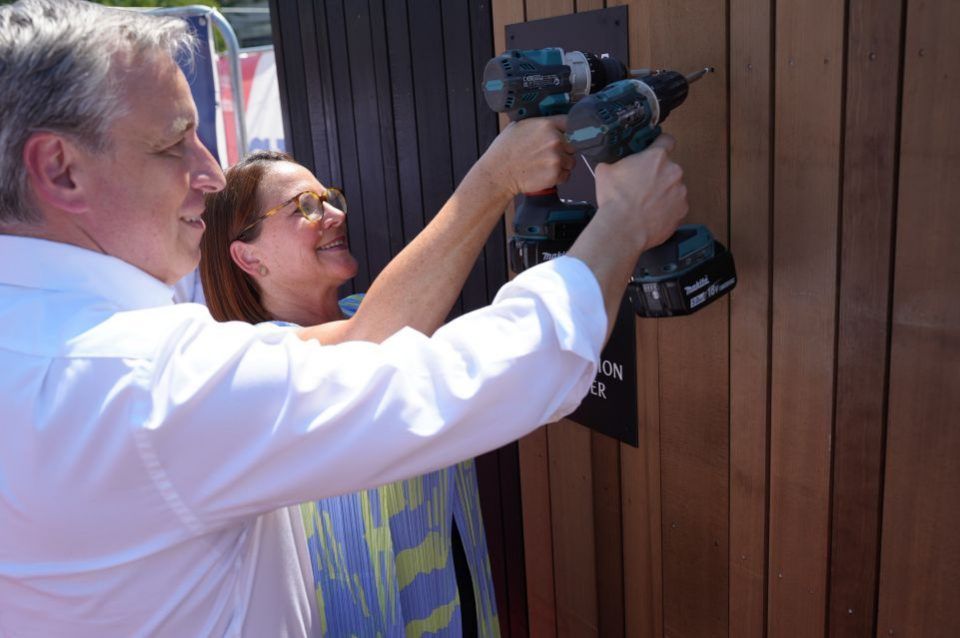Laying of the first board for Kiem 2050, a sustainable district in the heart of Kirchberg.

On July 1, 2025
Yuriko Backes, Minister for Mobility and Public Works, and Claude Meisch, Minister for Housing and Spatial Planning, together with Marc Widong, Director of the Kirchberg Fund, representatives of Immobel Luxembourg and Prefalux Group, laid the first beam of the Kiem 2050 project in Kirchberg.
A Concrete Response to Housing and Climate Challenges
Luxembourg is facing significant real estate pressure, particularly in strategic areas such as Kirchberg — a district with strong potential for urban diversity and sustainable development. At the same time, climate challenges demand a reinvention of construction practices. Kiem 2050 stands at the intersection of these essential issues.
The neighborhood will feature 135 housing units ranging from 52 to 136 m², from studios to five-room apartments, intended for a diverse public — from young professionals to families — in a clearly defined framework of social diversity. An innovative co-living model will complement the offer, in line with the evolution of urban lifestyles: more flexible, shared, and community-oriented.
“The partnership with Immobel and Prefalux reflects our desire to improve access to home ownership while providing a sustainable and high-quality living environment,”
emphasized Marc Widong, Director of the Kirchberg Fund.
On average, the affordable housing units built under the project will be offered at a price around 30% below market value.
“The launch of the Kiem 2050 project marks a concrete step in our commitment to addressing the housing crisis.
By creating quality, accessible, and sustainable housing in the heart of Kirchberg, we are strengthening not only social cohesion but also Luxembourg’s economic competitiveness.
This project perfectly illustrates what we can achieve when the public sector — through the Kirchberg Fund — and private stakeholders join forces.
Through this close and responsible cooperation, we will be able to produce, on a large scale, the housing our country urgently needs,”
stated Claude Meisch, Minister for Housing and Spatial Planning.
Building Better: Ecology, Sharing, and Innovation
Kiem 2050 embodies a strong commitment to eco-construction.
The district is based on bio-sourced architecture, featuring solid wood structures — a material with a low carbon footprint and high energy performance. The project integrates passive technologies such as the Canadian well, a geothermal system that naturally regulates indoor temperature. Combined with photovoltaic panels installed on rooftops, this system reduces energy consumption by nearly 20% compared to traditional buildings.
Green roofs enhance the sustainable approach by improving thermal regulation, promoting biodiversity, and supporting responsible rainwater management.
Soft mobility lies at the heart of the plan, with dedicated infrastructure for pedestrians, cyclists, and public transport users. The district is designed to minimize motorized traffic flows, prioritizing comfort and safety.
“This project embodies the pillars of our strategy: carbon reduction, circularity, biodiversity, and collective well-being,”
said Muriel Sam, CEO of Immobel.
Kiem 2050 is also conceived as a genuine living and meeting space.
It will feature 400 m² of shared indoor areas, including a library, yoga room, creative workshops, and a shared kitchen — fostering social interaction and community initiatives.
Active ground floors will create a dynamic interface between private and public spaces, energizing neighborhood life through a variety of local services.
Outdoors, 5,000 m² of shared spaces will include collaborative gardens, rooftop terraces, playgrounds, and relaxation zones — offering a friendly and peaceful environment in the heart of the city.
Finally, the wood-steel buildings of Kiem 2050 are designed to be demountable and reusable, with each component separable to promote recycling and circular economy principles.
Yuriko Backes, Minister for Mobility and Public Works, stated:
“The Kiem 2050 project demonstrates that it is possible to combine urban growth with ecological transition.
By designing urban spaces for pedestrians, cyclists, and public transport, we promote residents’ well-being while actively reducing our carbon footprint.
This initiative not only addresses immediate housing needs but also anticipates the future requirements of a sustainable, connected, and inclusive city.”
Kirchberg: A Strategic Development Hub
Located in the northeast of the capital, Kirchberg has established itself as a strategic development hub, hosting major European institutions such as the Court of Justice of the EU, the European Parliament, the European Commission, and the European Investment Bank.
It is also home to major international companies (including Amazon and soon ArcelorMittal), banks (BIL, Spuerkeess, BGL BNP Paribas, Deutsche Bank), and Big Four firms (KPMG, EY).
One of Kirchberg’s main strengths is its accessibility.
The district is served by an ever-expanding multimodal transport network.
The tram, with its new extension directly serving Kiem 2050, connects Kirchberg to the city center in 15 minutes, the central station in 20 minutes, and Luxembourg-Findel International Airport in 12 minutes.
Convenient connections to local and regional bus lines are also available, as well as to the Pfaffenthal-Kirchberg multimodal station, providing efficient links to national railway lines.
The district is also directly connected to motorways A1 (toward Trier) and A7 (toward northern Luxembourg).
Additionally, the area benefits from a rich immediate environment with public services such as schools (including the European School), modern hospital infrastructure (Schuman Hospitals), cultural venues (the Philharmonie and MUDAM), and numerous shops.
Meeting the Needs of a Changing District
The Kiem 2050 residential project fully aligns with this urban and economic momentum, responding to the needs of contemporary city dwellers in terms of housing, sustainability, and functional proximity.
With population growth exceeding 15% between 2021 and 2023 (from 7,600 to 8,746 inhabitants), projections estimate nearly 23,700 residents by 2040.
The development of the nearby Kuebebierg site will further reinforce this trend.
Kirchberg’s population is young and active, with around 68% aged between 18 and 64.
This profile reflects the district’s attractiveness to an international, mobile, and highly qualified population, working in finance, law, European institutions, and professional services.
In this context, Kiem 2050 emerges as an integrated and forward-looking urban response.
Its location within a rapidly evolving, European, ecological, and innovative district makes it a flagship project of Luxembourg’s urban development.







